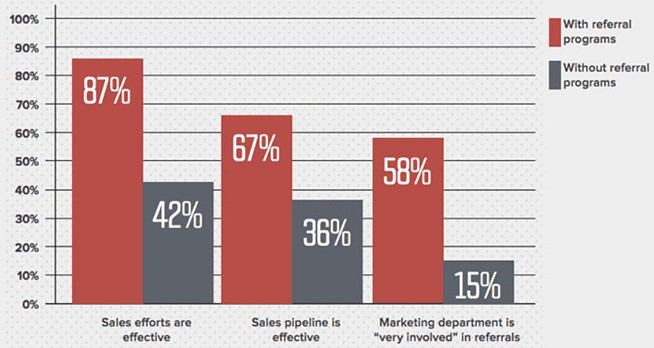So you've put your money into building the best possible advertising campaigns. And you're attracting clients... but at too slow a rate—and you're probably wondering what to do about it.
In short, you're pouring cash into marketing but not getting the returns that you need. Why?
Well, there's a good chance that you're overlooking an important factor that can both save you money and grow your client base. We're talking, of course, about client referrals.
What are client referrals?

Have you ever been so impressed with a worker that you recommended the person to a friend? If so, you were making a client referral—though you might not have thought about it in those terms.
There are two types of client referrals. Some, like the worker example, are organic: A client is impressed with your work and decides to recommend you. The second type is prompted: You suggest to clients that they refer you—and you might offer some incentives for them to do so.
The second scenario is an example of referral marketing, which can give your business a significant boost.
Here are nine simple ways to set you on the right path to referral marketing.
1. Provide the best service
It goes without saying, but clients will recommend you only if you provide an excellent service.
Think you're already providing top-notch work? Perhaps so, but there will always be some aspect of your work that can be improved. Perhaps you completed work on time, but what could have been done to ensure it was finished ahead of schedule?
You might want to introduce new systems to improve client experiences.
Receiving low numbers of referrals is a good indication that your service can be improved. It's not enough to simply provide a good service; the businesses that get the most referrals regularly exceed expectations.
2. Make referrals as simple as possible
The more effort clients have to put in to make a referral, the less likely they are to make it. That's why it's your job to make referrals as simple as possible. Asking a client to make a word-of-mouth recommendation may work; often, however, a client will forget or move on to other things.
Instead, you could write a template for clients to use. Of course, not all clients will like that approach. Make sure that you don't seem pushy when asking for a referral. Avoid sending a pestering checking-in email, which will only turn clients off.
3. Offer incentives
Wondering how to get client referrals? Nothing beats the power of a reward. That's especially true for referrals.
What you offer to your clients is entirely up to you.
4. Create shareable content
No marketer should underestimate the power of content. The first step is to create a post that speaks to your audience. But it's not good enough for a blog or social media post to simply be interesting. The most effective content should be engaging enough to encourage readers to share with likeminded colleagues and peers. As new readers find your content, they'll want to investigate your company more. That content can be as simple as providing a photo of your product that will appeal to people.
5. Keep in touch with your current clients
If you want clients to recommend you, they need to remember you. Just because clients had a favorable experience doesn't mean they will think to refer you in a year's time. A brand that builds loyalty with its clients is much more likely to receive client referrals.
But where should you begin? A simple start may be a personalized birthday greeting, which would help to keep you fresh in the mind of clients.
Some form of personalization is expected: 70% of customers say their loyalty is influenced by a companies' efforts to get to know them.
6. Get to know your clients
Personalization shouldn't relate just to the materials you send after working with a client. The entire experience with you needs to be personal to them. Before carrying out any work, get to know the client. It's always best to start with an old-fashioned phone call (or for an up-to-date solution, you could look at some Vonage alternatives for higher-quality audio).
Understand clients' needs and the goals of their project. Each step of the client journey should feel tailored to them. The more personal you can make your service, the more likely a client is to make a referral.
You can facilitate the process by interacting with your customers regularly, seeking their opinions through questionnaires and surveys, acknowledging their input, and making sure they feel valued.
7. Remember reviews
Client reviews are becoming the first port of call for new client relationships. Reviews can also be a useful form of indirect client referrals.
If a potential client sees a positive review, they'll feel more confident that your business is trustworthy and reliable. That's why the more positive reviews that you have, the better. If clients are happy with your service, you should encourage them to provide a review.
8. Respond to feedback
Not all your feedback will be positive. Inevitably, at some point, you will make a mistake. But what should you do when a client makes a negative comment about your business?
Though it might be tempting to argue, it's more useful to act on feedback. Be active, respond publicly, and offer to resolve their problems privately. (You don't want all of your exchanges to be available for everyone to see.)
When you respond and act, you prove to clients that you're on their side; you're also much more likely to receive referrals.
9. Make your offers referable
Sending out offers to current clients is an important part of building brand loyalty. But offers are even more effective when they can be shared. When you send a promotional offer to a client, it's best to have a means for them to share it with others. Also think of new ways to provide incentives so that they're more inclined to refer your services to other businesses. You can encourage them by sending your links via email or social media to make them easily shareable.
Referral marketing is a must
There are no real downsides to referral marketing. Because it relies largely on word-of-mouth, there are few related costs; and if it's done correctly, the result is low-cost, or even free, advertising.
Now you know how to get client referrals. But putting the steps outlined in this article into practice can be easier said than done. Above all, you'll need a strong commitment to your audience. In whatever capacity your people are working in your company—from Finance to Marketing—they should put client satisfaction as a top priority.
But by putting aside time and making an effort, you can craft a winning referral marketing strategy.
More Resources on Client Referrals
Customer Referral Programs: Top Methods and Rewards




